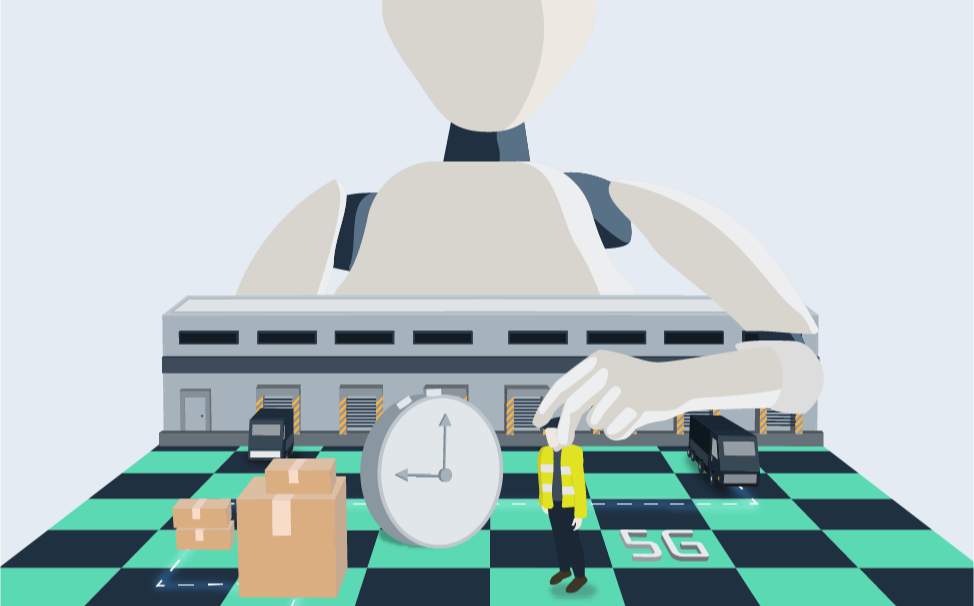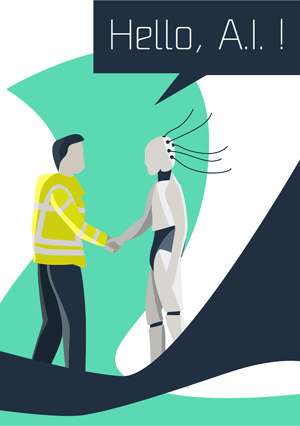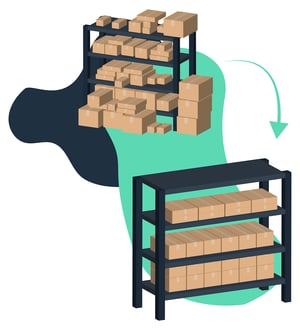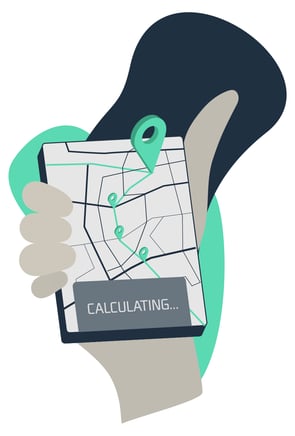Artificial Intelligence in Retail: What Does it Mean for the Industry?

Are you looking to make machine learning analytics work for your retail operation? Part one of this two-part blog series has 4 tips that could answer some questions.
Stay tuned for part two of this blog post which will be published on April 28, 2020.
If you aren't thinking five moves ahead in today's high-stakes game of retail chess, you'll find your business outmaneuvered and backed into a corner. The key to winning this game is being able to decide on the right technologies to leverage in the fight.
Just as a chess master must choose whether to zig and zag like a knight or make a laser-straight run with a bishop to outsmart the opponent, selecting the right tool to optimize retail operations will depend on a lot of factors. In this paper, we will look at the various challenges facing retail today and then focus in on a technology that many are choosing as a solution.
Hello, A.I.!
This time we'll be considering artificial intelligence (AI) as a promising new tool to solve retail challenges and drive bottom-line results. Although it's been around for a while, AI is just now coming into its own as a supply chain tool. As you'll read below, it's got tremendous promise as a means to streamline operations by improving processes like routing and by making autonomous driving possible.
Once those technologies become the norm, you will be challenged to keep up without modernized practices. That's why we at C3 Solutions want to share what we've learned about AI and how it fits in the retail supply chain.
One of the ways we see future success is through the proper application of technology like automated yard and dock management. Once those automated trucks start rolling, being able to seamlessly manage operations at the dock doors will be an even more critical function than it is now.
We hope you find this exploration of AI interesting and helpful as you plan for the continued and future success of your retail operation.
The Challenges
Did you know that delivering 25 parcels by road could offer 15 septillion possible route options?1 Home deliveries seemed like a simple process – send the truck out, let the GPS guide the driver and a few hours later everything's delivered.
But with parcel deliveries topping 87 billion in 20182, and 2,760 shipped every second of every day, that's a lot of permutations and calculations being made around the world to get them to their final destinations. Even 15 years ago we did not have the computing power or capability to crunch numbers on this scale.
All this activity is being driven by e-commerce and customers' increasing demand for fast-as-possible deliveries. Known as the "Amazon effect", thanks to the e-commerce giant's ability to fulfill orders quickly and accurately and the resulting inflation of customer expectations, it has fundamentally shifted the retail marketplace from one where price was a differentiator, to one where delivery speed makes the sale.
Alongside Amazon's dominance, the technology in customers' hands also plays a huge role. On Cyber Monday in 2018, 54% of shoppers were using mobile devices, and 30% of actual purchases were completed by mobile, netting US$7.9 billion in revenue for online retailers.3
The growing penetration of mobile into retail means customers are perpetually ready to shop, very well informed, and are able to make purchasing decisions on the fly. Retailers are now challenged to keep up with that trend and make sure they can stay one step ahead of the always-on customer.
On the operations side, the need for speed creates multiple challenges. It means traditional suppliers are being forced to step into the last-mile delivery game, turning themselves into retail omnichannel operations. It means a greater emphasis on flexibility and gaining the ability to adapt to changes in demand. It means having to implement stronger returns and reverse logistics practices. It means having a pinpoint-accurate inventory control system and demand planning in place to prevent stockouts, which in the world of e-commerce almost always mean a lost sale.
Failure to meet these challenges has disastrous consequences, as the staggering number of retail bankruptcies and closures in the past few years demonstrates. In 2019, the third week in September, 8,500 stores were closed in the United States alone, and a forecast suggested 12,000 might be the final tally by the end of the year.4 That represents those shuttered due to bankruptcies and downsizing.
But at the same time, the U.S. retail industry is expected to report growth in the range of 3.8 percent to 4.4 percent by the end of 2019, thanks largely to e-commerce.5 Clearly retailers need a new way to understand and execute business processes if they are going to survive and thrive.
 What Exactly is AI?
What Exactly is AI?
Staying alive in this environment requires fast thinking and a sound understanding of the technologies that can keep your business in the game. Artificial intelligence is one of the most interesting new game changers in the retail landscape. It's been described as "the single biggest technology revolution the world has ever seen".6
Actually, AI is larger than one single technology. It is a collection of systems that allow a computer to "sense, comprehend, act and learn".7 Rather than relying on coding that anticipates binary decisions to make a process happen, AI allows the computer to figure out how to act by analyzing data instead.
The computer is programmed with algorithms, a set of guidelines in the form of sophisticated code that allows the machine to adapt as it works, changing the output based on the data it's fed. Examples of AI that we take for granted now include the online recommendations that pop up in our social media feeds or in online shopping apps. It's also hard at work making stock market trades, operating your smart home assistant and flying planes.
Adoption of machine-learning technology – another term for AI – has the potential to resolve issues of time, resources and cost. Analytics is the branch of AI that will do the most in this area, as it represents the ability to crunch the numbers in vast quantities of data where humans can no longer keep up.
AI is set to make a dramatic impact on business around the world. One estimate places its economic impact at US$15.7 trillion by 2030 – that's an uptick of 14 percent in global GDP. Of that, about $6.6 trillion will come through productivity gains and the rest from consumption.8
Many are pinning their hopes for business success on it. Numerous surveys have asked executives about their plans for AI adoption, and the number who say they plan to use it tracks as high as 75 percent.9 The retail and consumer goods segment of the global supply chain analytics market alone is expected to grow from US$1.2 billion in 2019 to $2.5 billion in 2024 – that's an annual growth of 16.2 percent.10
In general it's expected that AI will affect three areas: productivity gains through automation of processes (including automated vehicles and robots); productivity gains through application of AI to assist the existing labour force; and, increased demand thanks to the ability to increase product personalization.11
What Can AI Do for Retail Operations?
Retail operations stand to benefit from AI in many ways, and in ways that have yet to be envisioned or realized. However, for the moment AI is seen predominantly as a means to streamline inventory control and profit by improving processes.12 Crunching the vast amounts of data being generated from observing e-commerce shopping habits, Internet of Things connected objects, and sales information can yield reams of actionable insights.
But retail operations will also be influenced by the use of AI in the service sectors it relies on. AI in transportation and logistics, for example, will have a huge impact on how retail operations will need to function. AI applications that improve routing – as we noted above – as well as load matching, and in the not-too-distant future autonomous trucks, will all contribute to a faster, more efficient transportation system.
In the meantime, here are some of the top AI applications that are proving to have a beneficial direct impact on retail.
1. Inventory Optimization
 In the cutthroat retail world, inventory optimization is a key survival tool. One of the ways that AI can help is by providing accurate predictions of future sales. Demand planning is now part of the analytics tools that AI can provide, and will allow retailers to reduce excess inventory by only buying what these predictions indicate is needed. The other benefit is that the amount of space needed to store inventory may be vastly reduced if the quantities needed are foreseen accurately.
In the cutthroat retail world, inventory optimization is a key survival tool. One of the ways that AI can help is by providing accurate predictions of future sales. Demand planning is now part of the analytics tools that AI can provide, and will allow retailers to reduce excess inventory by only buying what these predictions indicate is needed. The other benefit is that the amount of space needed to store inventory may be vastly reduced if the quantities needed are foreseen accurately.
This does present a risk on the flip side, however, if demand exceeds predictions and the retailer is caught short. Overstocks cost retailers US$470 billion in 2015, while out-of-stocks caused a US$630 billion hit, globally, according to one study.13 But with the increased accuracy, and continuous learning that AI affords, both types of inventory miscalculations may eventually be remembered as headaches of the past.
2. Delivery Optimization
 Going back to the route-planning problem noted above, AI is already being employed to ensure packages get delivered with the maximum efficiency. A major parcel delivery specialist has been using such a system since 2013, and now employs it on 10,000 routes. It uses fleet telematics and advanced algorithms to provide drivers with optimized routes. The technology figures out the most efficient way to deliver and pick up packages within a set of stops defined by start time, committed delivery time, pick-up windows and special customer needs. The system relies on customized online map data to calculate miles and travel time to plan the most cost-effective routes.
Going back to the route-planning problem noted above, AI is already being employed to ensure packages get delivered with the maximum efficiency. A major parcel delivery specialist has been using such a system since 2013, and now employs it on 10,000 routes. It uses fleet telematics and advanced algorithms to provide drivers with optimized routes. The technology figures out the most efficient way to deliver and pick up packages within a set of stops defined by start time, committed delivery time, pick-up windows and special customer needs. The system relies on customized online map data to calculate miles and travel time to plan the most cost-effective routes.
For the delivery company's retail partners this means e-commerce parcels will be delivered faster and for less cost. It also means that those same retailers will feel even more pressure to step up the speed and efficiency of their own operations.
3. DC Process Improvement
 AI is being used by third-party logistics (3PLs) suppliers to predict when customers will need orders and then organize their distribution centres accordingly. If you know when a pallet will be needed it's possible to stage orders so that they can be most efficiently picked and loaded onto waiting trucks.14 AI is taking old-school analysis of fast-moving SKUs versus slow moving product to a whole new level, based on order history and factors such as seasonal demand and even weather patterns, in the case of cold storage suppliers handing items like ice cream and frozen treats. And for the company in this example, it's paid off with a 20 percent improvement in efficiency.15
AI is being used by third-party logistics (3PLs) suppliers to predict when customers will need orders and then organize their distribution centres accordingly. If you know when a pallet will be needed it's possible to stage orders so that they can be most efficiently picked and loaded onto waiting trucks.14 AI is taking old-school analysis of fast-moving SKUs versus slow moving product to a whole new level, based on order history and factors such as seasonal demand and even weather patterns, in the case of cold storage suppliers handing items like ice cream and frozen treats. And for the company in this example, it's paid off with a 20 percent improvement in efficiency.15
4. End-to-End Supply Chain Planning
AI will be able to enable planning across the supply chain from raw materials right through to the end retail consumer. In the best case scenario, it will entail being able to better plan everything from how much of a sourced material will be required and the precise moment it needs to be delivered to the manufacturing plant, through to knowing when demand for that product will peak and then being able to suggest it to the right customer and have it delivered the same day.
This will reduce costs all along the supply chain by reducing delay, avoiding wastage in manufacturing, eliminating unwanted inventory and the extra touches and storage it requires, and minimizing the cost of lost sales due to stockouts. If done correctly, AI has the promise to deliver benefits all the way along the chain.
Stay tuned for part two of this blog post which will be published on April 28, 2020.
REFERENCES
[1] "How AI is spreading throughout the whole supply chain", The Economist, March 28, 2018.
[2] "Global parcel volumes up 17 percent", Inside Logistics, October 11, 2019.
[3] "Mobile eCommerce Stats in 2018 and the Future Online Shopping Trends of mCommerce", Justin Smith, OuterBox, April 22, 2019.
[4] "Weekly US and UK store openings and closures tracker 2019, week 38", Coresight Research, September 20, 2019.
[5] Global Supply Chain Analytics: Technologies Market, BCC Research, August 2019.
[6] "ExplAIned – A guide for executives", Ray Eitel-Porter, Accenture, September 21, 2018.
[7] "What is AI exactly?", Ray Eitel-Porter and Athina Kanioura, Accenture, September 21, 2018.
[8] Sizing the prize, What's the real value of AI for your business and how can you capitalize?, Anand S. Rao and Gerard Verweij, PwC, 2017.
[9] "ExplAIned – A guide for executives", Ray Eitel-Porter, Accenture, September 21, 2018.
[10] Global Supply Chain Analytics: Technologies Market, BCC Research, August 2019.
[11] Sizing the prize, What's the real value of AI for your business and how can you capitalize?, Anand S. Rao and Gerard Verweij, PwC, 2017.
[12] "The Future of AI-Driven merchandising", Joe Skorupa, RIS News, June 26, 2019.
[13] "How AI is spreading throughout the whole supply chain", The Economist, March 28, 2018.
[14] "How AI is spreading throughout the whole supply chain", The Economist, March 28, 2018.
[15] "5 Examples Of How AI Can Be Used Across the Supply Chain", Blake Morgan, Forbes, September 17, 2018.

